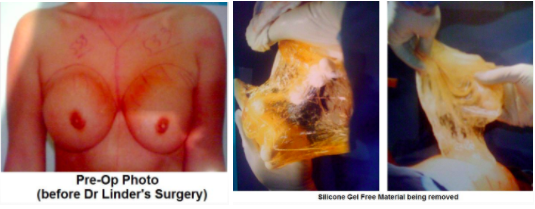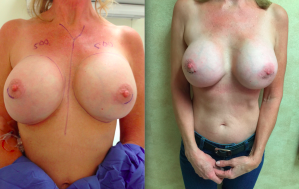Ruptured Silicone Gel Implant
Posted On: January 03, 2018 Author: The Office of Dr. Stuart Linder Posted In: Breast Revision, Ruptured Implant
Dr. Linder performs breast revision surgery on patients from around the world. The most common revision surgery is due to ruptured silicone implants. Interestingly enough, only true MRI readings can find an implant rupture, as mammograms can show that the implant is still intact.
Operational Findings
Case in point, the patient below is a 47-year-old female from Sweden who underwent a breast revision 18 years ago. The implants were said to be intact on the mammogram; however, the patient felt there might have been loose material, as well as sagging and scar tissue formation, and desired to have the implants removed. In the operating room, she was found to have bilateral ruptured silicone gel implants and massive scar tissue calcification. The photos show silicone gel free material being removed from the breasts as well as calcifications and severe encapsulation.

The 54-year-old female patient came to me regarding increasing pain in her left breast, which appeared after a motor vehicle accident. She presents with scar tissue contracture of the left breast preoperatively as well as the right inferior bottoming out. The MRI shows complete rupture of the left silicone gel implant with intra and extracapsular rupture. Her photographs show evidence intraoperatively of complete rupture of the silicone gel Mentor® implant—notice the loose silicone gel material. This patient not only had severe disfigurement after her trauma but complete rupture of the gel implant.

The photo on the right shows the patient three weeks after surgery. The sutures have been removed. Her breasts have been reduced using 500 ccs high profile style 68 Natrelle® saline implants. There has been some tightening affect, and there is no further scar tissue contracture. All silicone gel implant material has been removed.
Recommendations, Removal, and Replacement
Patients who have silicone gel implants and a history of trauma to the breasts should undergo an MRI to determine the integrity of the shell of the implants as soon as possible. In my practice, I recommend that patients who have silicone gel implants undergo an MRI every three years and should consider removal and replacement after 10 years, especially if there is an obvious sign of rupture. Please contact me today if you have had any changes in your breast implants.